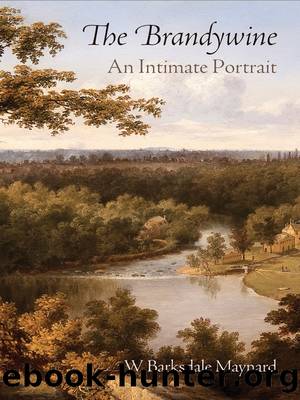The Brandywine by W. Barksdale Maynard

Author:W. Barksdale Maynard [Maynard, W. Barksdale]
Language: eng
Format: epub
Tags: Nonfiction, History, Americas, United States
ISBN: 9780812290738
Publisher: University of Pennsylvania Press, Inc.
Published: 2014-09-12T04:00:00+00:00
Quaker Horticulturists
Even before Wordsworth made the out-of-doors fashionable, Quakers appreciated natural beauty as a gracious manifestation of the Divine. âThe country life is to be preferred for there we see the works of God,â William Penn said as he founded his âGreen Country Townâ of Philadelphia. In his very first months in America he urged that Delaware Valley plants be sent to England to improve horticulture there. âThe woods are adorned with lovely flowers, for colour, greatness, figure, and variety,â he said. âI have seen the gardens of London best stored with that sort of beauty, but think they may be improved by our woods: I have sent a few to a person of quality this year for a tryal.â3
Pennâs followers included some of the most avid botanists of the colonial period, men who, by shipping plants abroad, helped revolutionize horticulture in the mother country, even as they laid the foundations for todayâs garden excellence locally. Most famous was John Bartram, born in the village of Darby near Philadelphia, then in Chester County. Later he turned his farm on the Schuylkill into Americaâs premier botanical garden. It is said that he died from anxiety that the British would wreck the place as they invaded Philadelphia after the Battle of the Brandywine.
Bartramâs passion for plants came to be shared by his cousin on the Brandywine, Humphry Marshall. A stonemason by trainingâand uneducated beyond age twelveâthe grave and reserved Marshall farmed and ran a gristmill on the West Branch. He began collecting plant specimens, and from 1767 to 1775 he shipped boxes of plants to fellow Quaker John Fothergill in England. Upon erecting his Marshallton house (still extant) from native stone in 1773, he made the grounds into only the second botanical garden in the colonies, copying the famous one of his cousin Bartram (see Plate 8). Magnolia, stuartia, fothergilla, and larch vied with other showy specimens. After the Revolution, Marshall became the leading American exporter of trees and flowering shrubs to England and France, a profitable trade. He sent plants to Sir Joseph Banks from 1786 to 1793, including snakeroot and martagon lily for the gardens of George III. His pioneering book on American trees, Arbustrum Americanum (1785), encouraged scientific study in the spirit of his friend Franklin, plus doubled as a sales catalog.4
West Chester botanist William Darlington wrote Marshallâs biography and catalogued the trees that survived in his overgrown Marshallton garden in 1849. Several gnarled specimens lived well into the twentieth century. Marshallâs arboreal collection inspired nearby Peirceâs Park, core of todayâs Longwood Gardens. And it encouraged the plantings in West Chesterâs Marshall Park, which pioneering forester and plant collector Joseph T. Rothrock, a distinguished resident of that town in late Victorian days, would call the nationâs best for the âselection of its noble trees.â The five-and-a-half-acre square was laid out in concentric circles in 1848 under the guidance of Darlington; its official authorization called for it to be filled with âvarious ornamental trees and shrubberyâ in memory of Marshall,
Download
This site does not store any files on its server. We only index and link to content provided by other sites. Please contact the content providers to delete copyright contents if any and email us, we'll remove relevant links or contents immediately.
| Canada | Caribbean & West Indies |
| Central America | Greenland |
| Mexico | Native American |
| South America | United States |
Cat's cradle by Kurt Vonnegut(15186)
Pimp by Iceberg Slim(14394)
4 3 2 1: A Novel by Paul Auster(12284)
Underground: A Human History of the Worlds Beneath Our Feet by Will Hunt(12024)
The Radium Girls by Kate Moore(11921)
Wiseguy by Nicholas Pileggi(5671)
Perfect Rhythm by Jae(5324)
American History Stories, Volume III (Yesterday's Classics) by Pratt Mara L(5256)
The Fire Next Time by James Baldwin(5249)
Paper Towns by Green John(5089)
Pale Blue Dot by Carl Sagan(4912)
A Higher Loyalty: Truth, Lies, and Leadership by James Comey(4845)
The Mayflower and the Pilgrims' New World by Nathaniel Philbrick(4423)
The Doomsday Machine by Daniel Ellsberg(4416)
Killers of the Flower Moon: The Osage Murders and the Birth of the FBI by David Grann(4386)
The Sympathizer by Viet Thanh Nguyen(4305)
Too Much and Not the Mood by Durga Chew-Bose(4274)
The Borden Murders by Sarah Miller(4247)
Sticky Fingers by Joe Hagan(4101)
